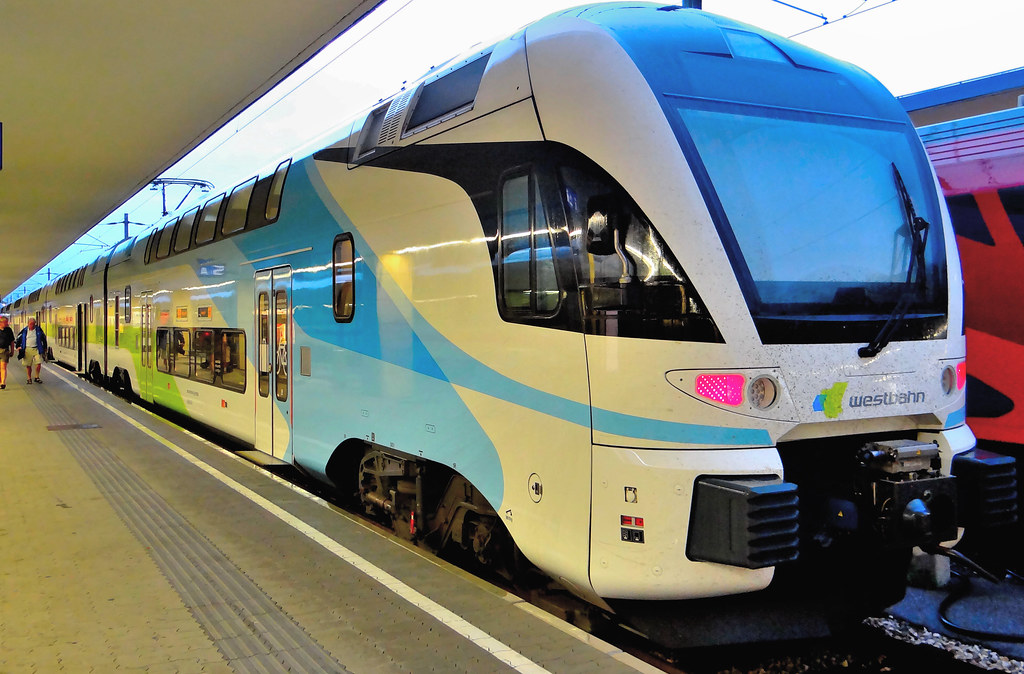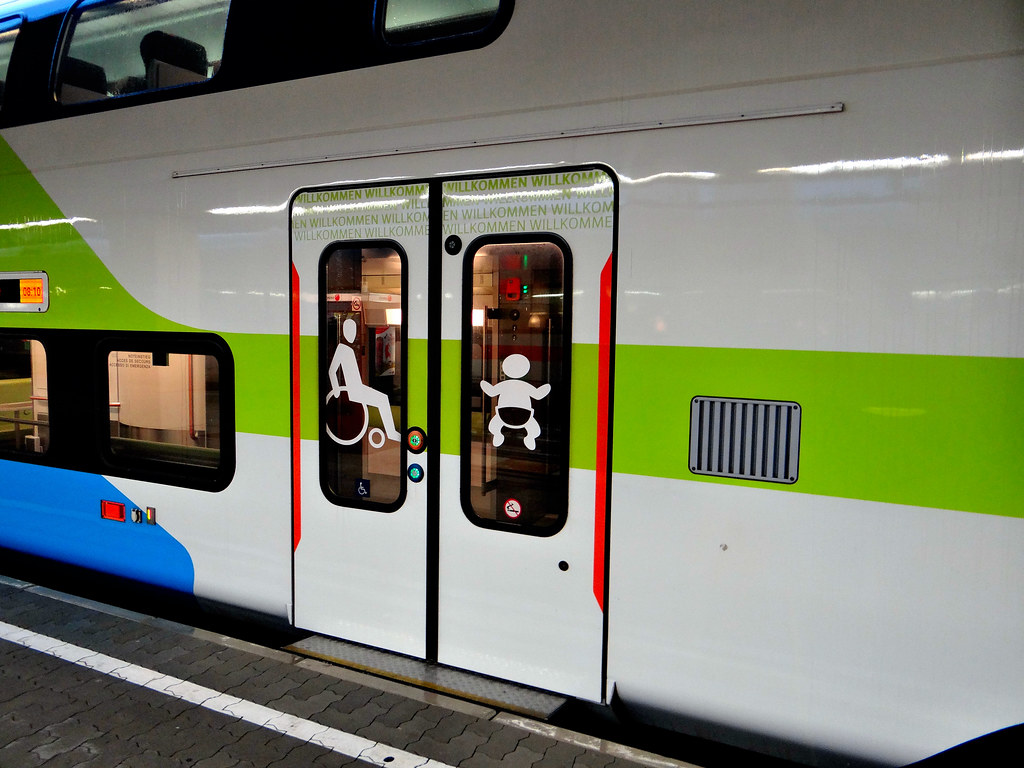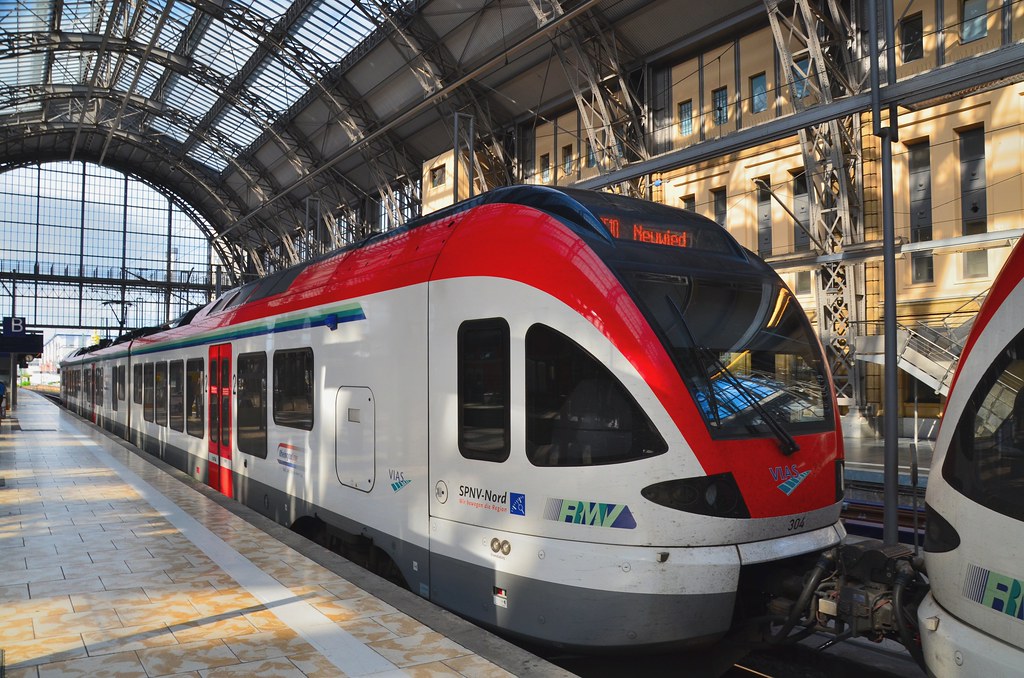raptor
Senior Member
source?Their plan is for double-level, yes.
source?Their plan is for double-level, yes.
Been talked about for 10 years plus, starting in 2007 with Metronauts Regional meetings.source?
There is nothing wrong with using double-deck trains so long as they have enough doors to deal with the on-off traffic.
A pic of the New Mexico RailRunner Bombardier Bi-Level, with luggage racks.

GO, Y U NO HAVE THIS?
I've always hated how the GO Trains dont have luggage racks.
Double-deckers are fine and even ideal for commuter systems but not for a RER type system.
Commuter rail basically just has one way travelers...…...people getting on throughout the route and everyone getting off at it`s termination ie Union. A RER system is, in many ways, more of a subway system with fewer stops. It is designed to move people about the region not to one particular stop like commuter rail. This means passenger flow and dwell times are far more important. Just as people tend to stand on a subway if only going a couple stations, people will do the same on RER clogging the fewer and thinner doorways. This will become even more acute as the number of wheelchair users rises as trains and stations, unlike in the past, are fully accessible.
Melbourne got rid of it`s double-decker trains for exactly that reason and is why the new Sydney Metro, even though much of it is using the current Sydney trains rail corridor, are going to be single level. In theory double decker trains look like they would carry far more passengers but the reality is quite different. The bi-levels may only have a few steps so logically it shouldn`t make any difference but people don`t act logically. I rode a bi-level in Rome and although the seats were full there was plenty of room for standees in the aisle but people, if they can`t get a seat, just wallow near the doorways. It greatly slowed the train for people getting on/off and one individual in a wheelchair had a hell of a time trying to exit even though being on the entry level. 6 people had to get off the train so the wheelchair rider could get off and on again and I remember if clearly as my brother and I were 2 of those 6 people.
One thing you seem to conveniently forget - GO isn't going to change what it already is, just add some stuff to its existing mandate.
People are still going to be taking the train for an hour or more each way every day. Simply calling it "RER" and wishing that away isn't going to change it.
Thus, you have to account for that. And thus, there's no reason why you can't use a double-decker. Design the lower level, where the doors are, for maximum occupancy and passenger flow, but the upper level with more comfort in mind. After all, this is what is done elsewhere, and it seems to be reasonably successful.
Double-deckers are fine and even ideal for commuter systems but not for a RER type system.
Commuter rail basically just has one way travelers...…...people getting on throughout the route and everyone getting off at it`s termination ie Union. A RER system is, in many ways, more of a subway system with fewer stops. It is designed to move people about the region not to one particular stop like commuter rail. This means passenger flow and dwell times are far more important. Just as people tend to stand on a subway if only going a couple stations, people will do the same on RER clogging the fewer and thinner doorways. This will become even more acute as the number of wheelchair users rises as trains and stations, unlike in the past, are fully accessible.
Melbourne got rid of it`s double-decker trains for exactly that reason and is why the new Sydney Metro, even though much of it is using the current Sydney trains rail corridor, are going to be single level. In theory double decker trains look like they would carry far more passengers but the reality is quite different. The bi-levels may only have a few steps so logically it shouldn`t make any difference but people don`t act logically. I rode a bi-level in Rome and although the seats were full there was plenty of room for standees in the aisle but people, if they can`t get a seat, just wallow near the doorways. It greatly slowed the train for people getting on/off and one individual in a wheelchair had a hell of a time trying to exit even though being on the entry level. 6 people had to get off the train so the wheelchair rider could get off and on again and I remember if clearly as my brother and I were 2 of those 6 people.
https://sydney.edu.au/news-opinion/news/2017/08/02/a-solution-to-sydney-s-peak-hour-train-crush.html[...]
Yet, the cost of Sydney Trains remains too high, because half the rolling stock is kept idle outside of rush hour. Our double-decker trains are a custom-built oddity. And each train has a driver and a guard.
Employing guards has increased the cost of rail services and has historically acted as a brake to investment in expanding the rail network. If the right technology is adopted, the need for guards will decline. Most of the world's heritage systems have moved to driver-only operation. Many newly built lines are driverless.
Our double-decker trains are very difficult to run at a higher frequency than they do now. They have more seats but carry fewer people than single-deck metro trains. We need more trains with more room and rail lines or else our city will have a stroke.
Game-changing rail infrastructure could be the backbone of an efficient, sustainable system that gets everyone home on time without breaking the bank.
The high-capacity driverless metro under construction offers a solution.
The new metro line is designed to carry 43,000 passengers per hour per direction (p/h/d). No Sydney Trains line can currently reach 20,000 p/h/d. Motorways only manage 2000 vehicles per hour per lane – mostly cars with one occupant.
The Sydney Metro – from Sydney's north-west to Bankstown – now under construction is an excellent idea and the Coalition governments should be praised for finally making it happen. Sydney Metro West from the CBD to Parramatta is also in the pipeline. But the Berejiklian government should keep moving in the right direction.
The City Circle tracks should be converted to metro and an all-stop metro line could run from Homebush through the City Circle to Revesby. This could be converted to carry a driverless metro like the Bankstown line or a metro with a driver, which wouldn't require the platform remakes of the Bankstown project but due to higher labour costs may be more expensive over time. Another pair of tracks, from Bondi Junction to Hurstville, is also ripe for metro conversion.
Together with the new line to Parramatta, these tracks would create a decent system for the most densely populated areas around the city. Metro conversions would facilitate the use of remaining tracks for longer distance, faster suburban trains with fewer stops.[...]
Something else I've wondered about GO's existing double-decker coaches: would there be a significant enough benefit to retrofitting it into 4- or 6-packs of articulated coaches (intertrain forces, ride quality), or would the drawbacks be too much (can't separate as easy, capital cost)? Interested to hear thoughts.
Hate to don some rose-coloured glasses for this point, but lots of the off-peak users are families with kids, and other individuals that are drawn to the train to take a nice, leisurely trip. The views from the top deck can be part of that draw. If we want to encourage ridership, particularly from people that would otherwise drive, why nix a design element that makes it pleasurable, to shave a few seconds per station in dwell time?
Why is that, considering there were lowfloor DD trains in Europe back in 2012??? High or low-floor platforms have no impact on electrification.
This train is like many others either high-floor or low-floor cars that have gap plates sliding out to fill the gap between the car and platform that better than what GO has today. This deal with clearance for freight and high speed trains. They come 3-9 car trains and mu 2-3 trains of different configuration. Seen 18 car trains made up as either 2 or 3 trains. Seen one of the trains cut from the main train along the way as either its not needed or being used on a branch line. Takes a very short time to decouple or couple.
(Vienna) [Wien] Photo


Frankfurt Germany

Depends on the rolling stock they purchase. Some trains like the Silverliners in Philadelphia have stepped access for low platforms and step free access for high floor stations.Why is that a waste? If they changed to high floor platforms would every platform need to be raised?




